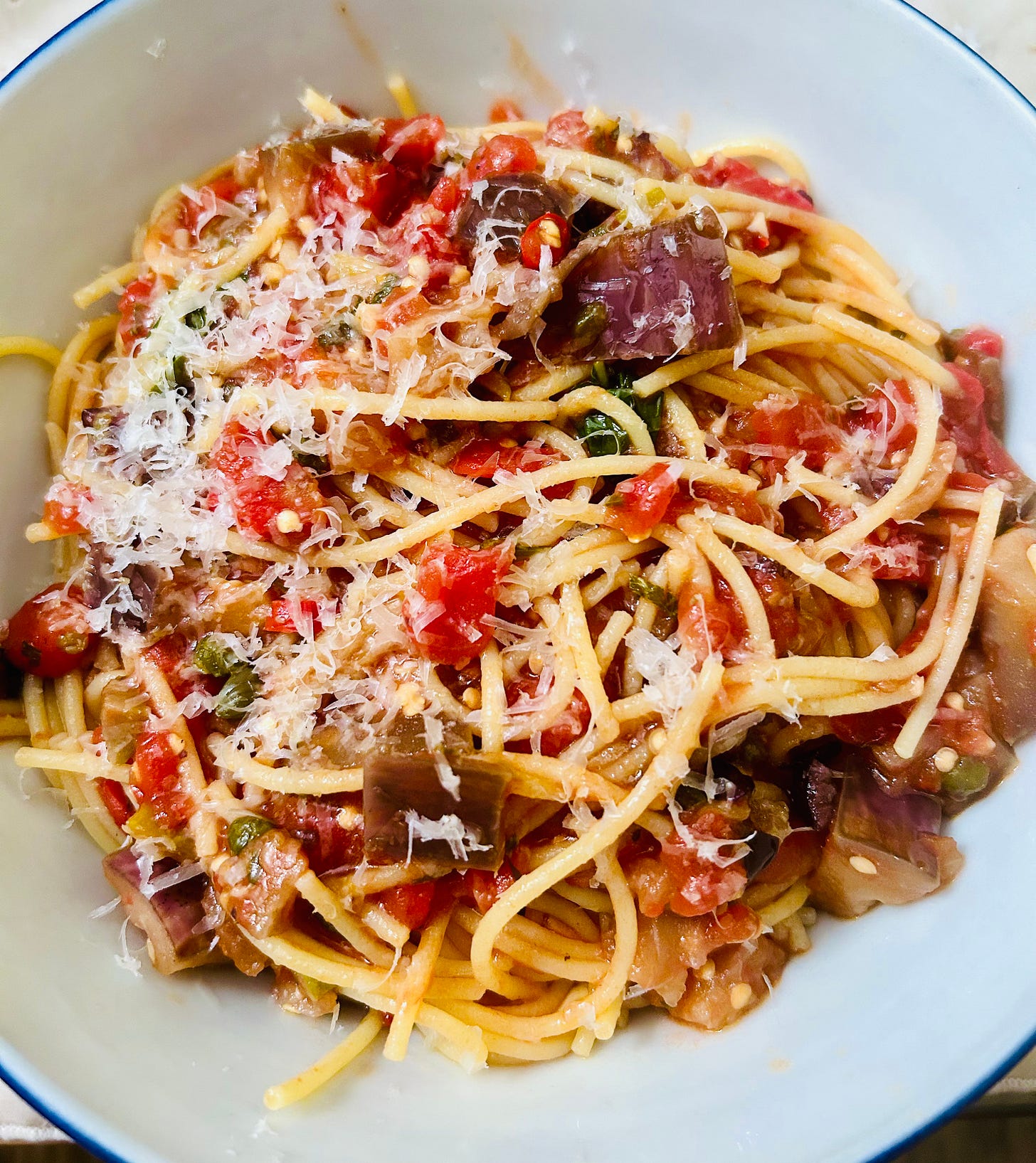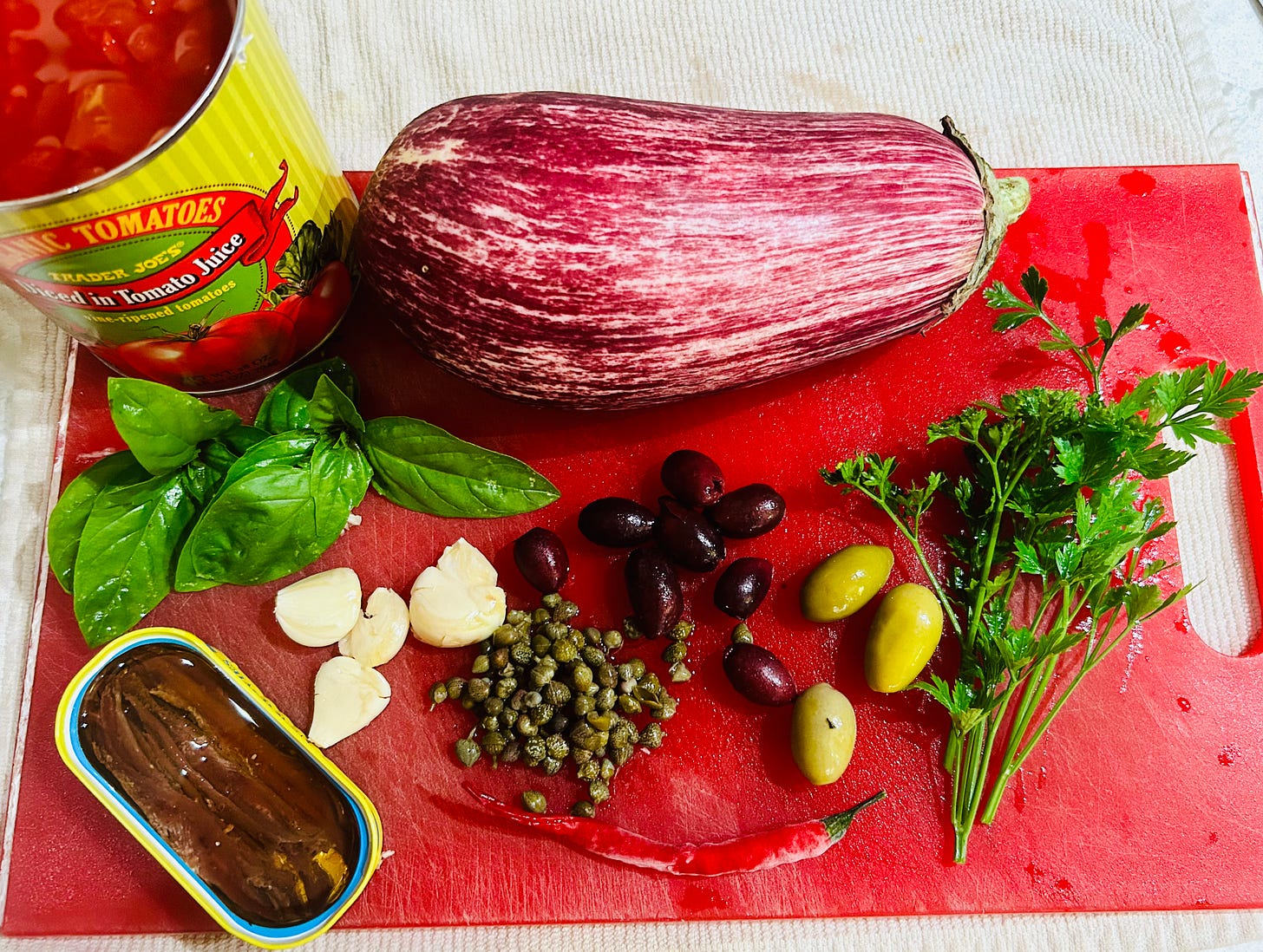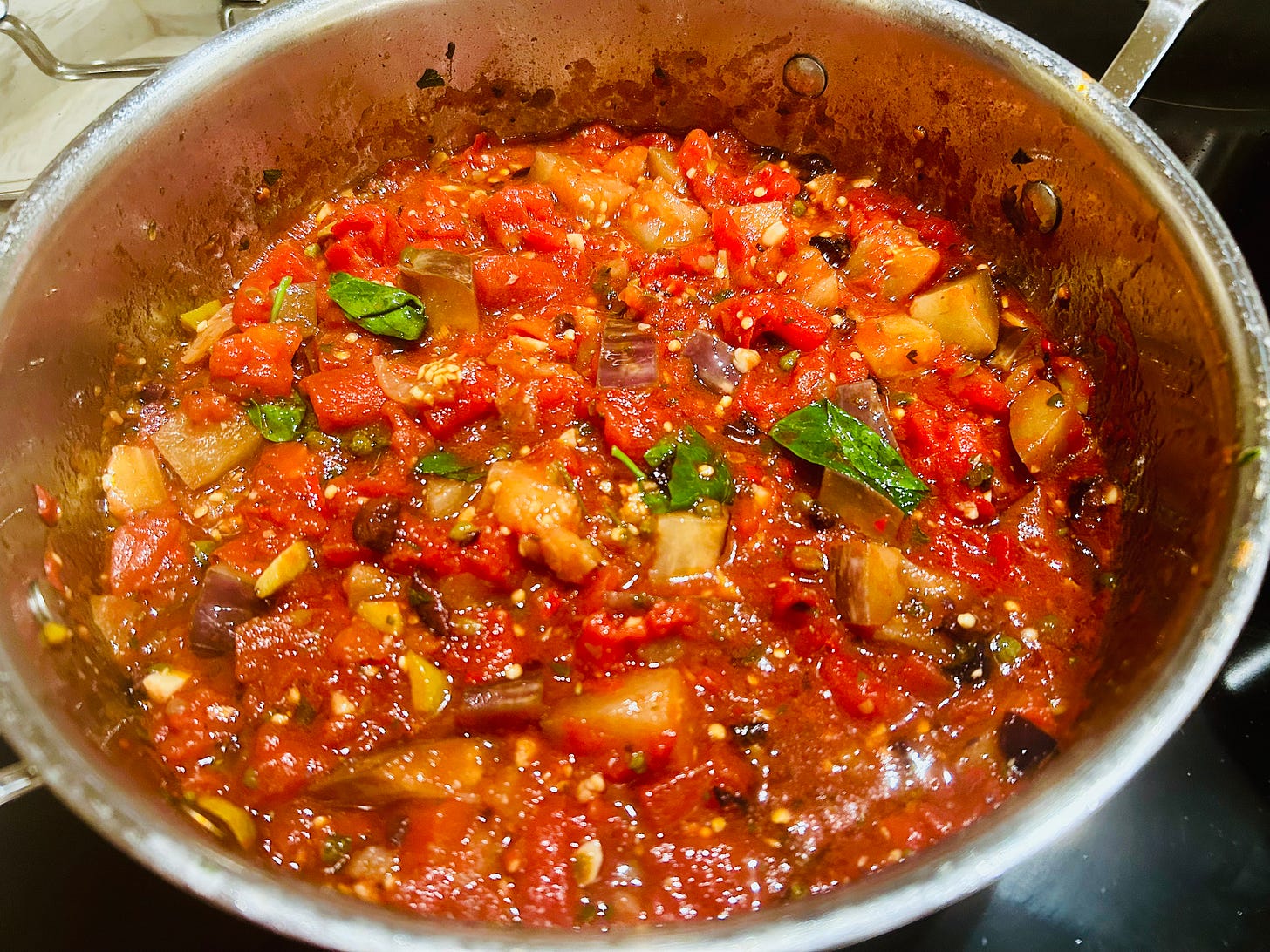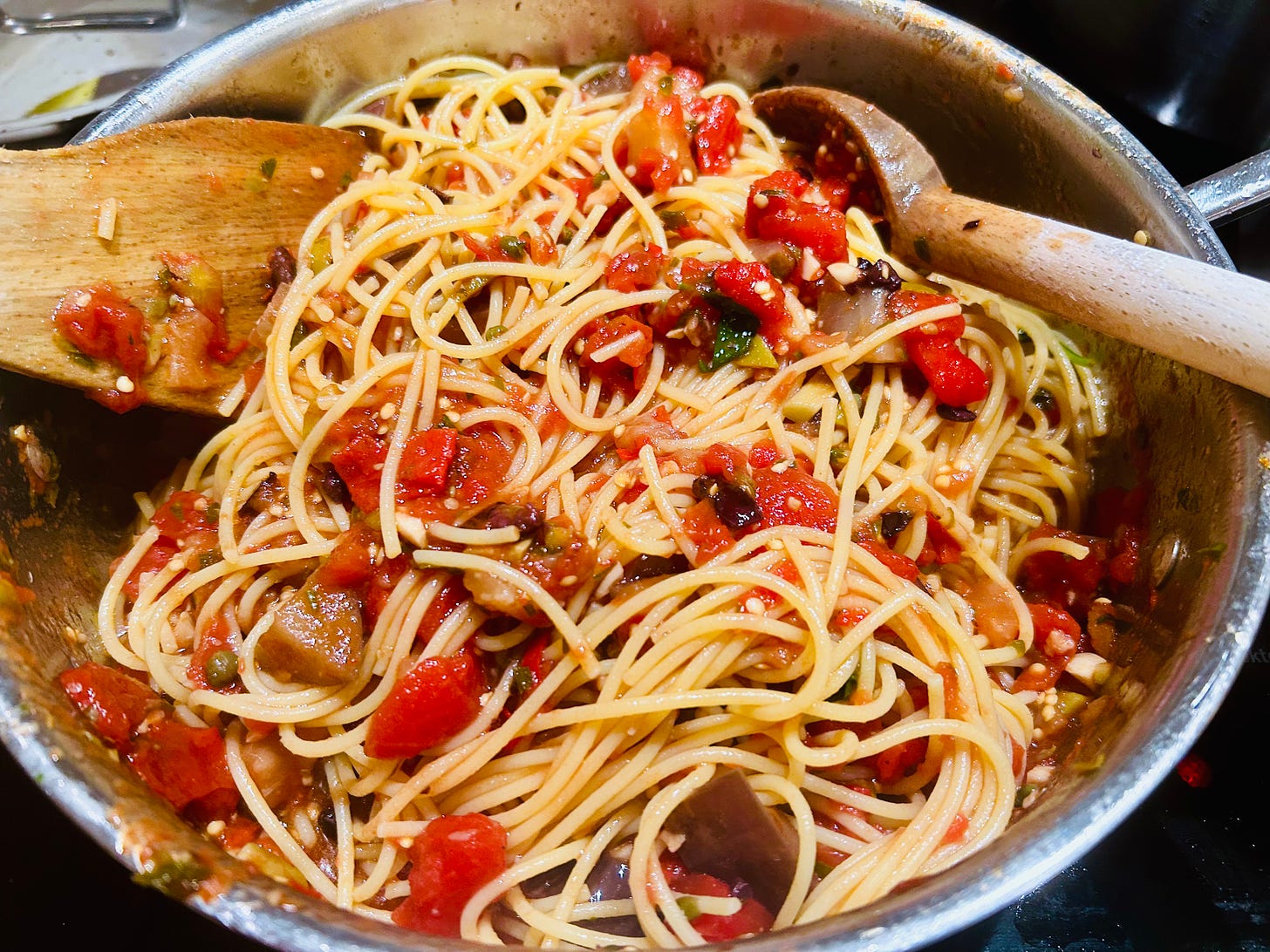Puttanesca Sauce for Pasta (Dante's Version)
Spicy, garlicky, tangy flavors bound together with fresh basil—you’re going to love this gluten-free sauce!

If you thought you’d never cook with anchovies, here’s your chance!
This recipe has been in my repertoire longer than any other, and making it always brings me happy memories. I learned it from an Italian cook after a wine-fueled gourmet meal in Tokyo. Back when I lived in Japan, working as an English teacher, I went to a home supper club hosted by a man named Dante. He served multiple courses and plied his guests with Sicilian wine. My friend and I ended up being the last guests standing. By the time everyone else had left, it was very late, and Dante decided to cook a meal for his kitchen staff. Standing beside Dante, I watched carefully as he chopped the ingredients and described the recipe, and my friend took copious notes. Many years later, I still have the handwritten notes, though I no longer need to refer to them.
Why is it called puttanesca (which roughly translates to hooker-style in Italian)? Well, Dante said it’s because you put some of everything in it. Another explanation I’ve come across is that the residents of Italian brothels would make this sauce because it makes use of many staple ingredients in Italian kitchens and can be thrown together quickly.
I’ve seen other recipes for puttanesca since I started following Dante’s recipe, so I know eggplant was his own addition. But improvisation is inherent in this recipe. Don’t be put off by the long list of ingredients. If you don’t have green olives, only the black, no problem! Just leave it out. No parsley? It will taste great anyway.
Basil is essential, however. I love the blend of flavors in this sauce, and they are all pulled together by the fresh basil, so use fresh leaves if you can (though I have used dried in a pinch). The sauce itself contains no gluten, so all you need to turn this sauce into a delicious gluten-free meal is a box of your favorite gluten-free pasta and a fresh salad. My favorite way to eat it is tossed with spaghetti, though other pasta shapes are also fine. If you want to a sprinkle some freshly grated Parmesan cheese on top, that is a nice addition, but I’ve also found that crumbled fresh goat cheese tastes wonderful with this spicy sauce.

Ingredients:
1 12- or 16-ounce package of gluten-free spaghetti or other pasta (see note1 on serving sizes)
3 tablespoons olive oil
4 anchovy filets, chopped
3 cloves fresh garlic, chopped fine
1 red chili pepper, chopped fine
1 28-ounce can tomatoes: diced, pureed, or crushed (I’ve also used fresh tomatoes)
2 tablespoons Italian (flat leaf) parsley, chopped
2 tablespoons black olives, chopped (see note2 on ingredient measurements)
2 tablespoons green olives, chopped
1 tablespoon capers, chopped
1 cup eggplant, cut into ½-inch cubes
10 whole fresh basil leaves (if you must use dried basil, about 2 teaspoons should do it)

Instructions:
For cooking your gluten-free pasta, put a large pot of salted water on high heat to boil, but don’t cook the pasta until the sauce is nearly ready to serve (see note3 on cooking dry gluten-free pasta and brands I like)
Sauté the chopped anchovies, garlic, and chili pepper in the olive oil for about a minute to release the flavor
Add the canned tomato and all the other ingredients, except the fresh basil, and stir
Simmer the sauce until the eggplant is tender, then add the whole fresh basil leaves (see note4 about cooking with fresh basil)
Drain the pasta and pour it into the sauce pan and toss it thoroughly to coat the pasta and serve in bowls, topped with freshly grated cheese
Depending on your appetite and whether your meal includes other dishes with the pasta, a single 12-ounce package will feed at least 2 adults, and a 16-ounce package can feed 3. This puttanesca sauce recipe will give you too much sauce for a single package of gluten-free pasta, so you can get more than one meal out of it. So, before tossing the pasta in the sauce, remove half the sauce to a sealable glass container; you can always add some sauce back to the pasta if you think it needs more.
The amount of chopped olives, etc., you use is really up to you; these measurements are to give you an idea of how much you might want to use. I often vary the ingredients based on what I have, and have omitted the green or black olives, the parsley, or the eggplant, and have substituted dried basil for fresh when basil was done growing for the season.
As I’ve mentioned in my other pasta recipes, such as lasagna, carbonara, or tomato/celery sauce, I the two brands of gluten-free pasta I use most often are Barilla and Colavita, which both come in a variety of shapes. Start heating your water before doing anything else so that it is ready when needed. If it comes to a boil too soon, turn down the heat and keep the water is hot until you need it. Once the water is boiling, add about a tablespoon of sea salt to the water, then add the pasta. Never trust the suggested cooking time on the package; always set your timer at least 2 minutes shorter than the suggested time and test the pasta before draining it. That is the only way you’ll be sure to have al dente pasta that won’t fall apart when you toss it with the sauce. The pasta should still be quite firm; remember that it will continue to cook as you toss it in the hot sauce.
When using fresh basil, the flavor can be ephemeral, so, for any dish where the basil is to be cooked over heat, I add it just a few minutes before the dish is to be served. The basil will wilt, releasing its essential oils into the sauce (you will smell it rising up from the pan). Also, while many might say it doesn’t matter, I’ve come to think that using the leaves whole, rather than chopped, gives a better flavor.




